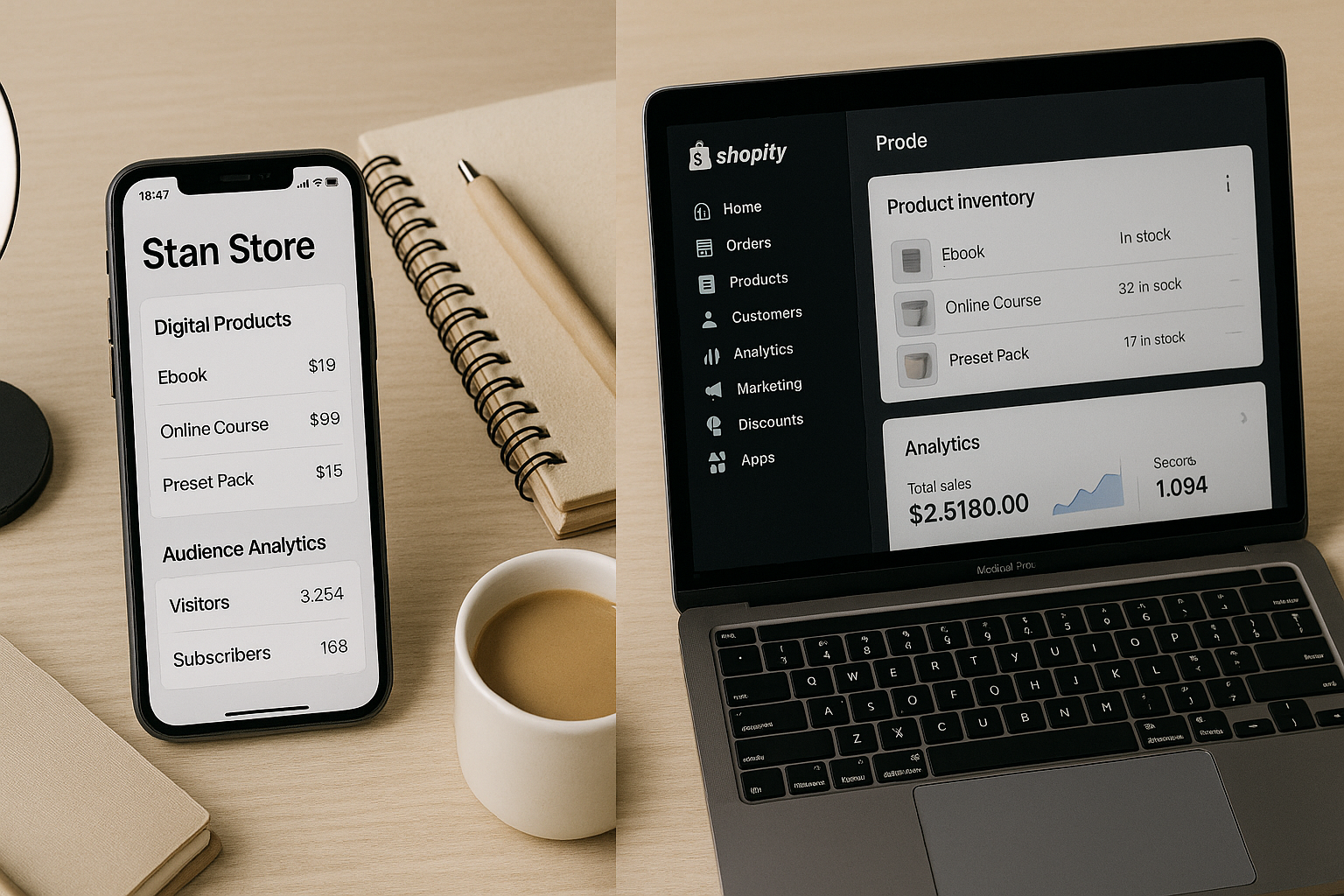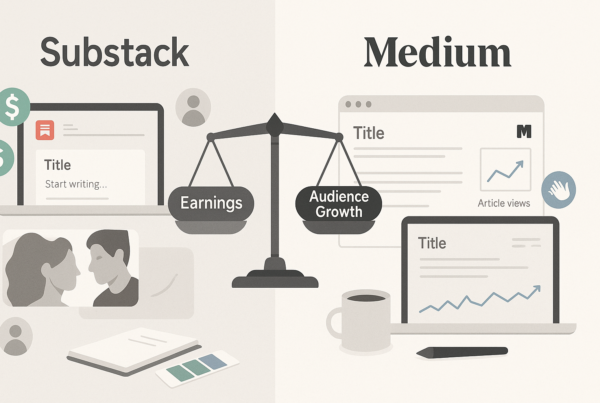When it comes to choosing between Stan Store vs Shopify, creators face a crucial decision that impacts how they sell and deliver their digital products. Stan Store has helped producers generate over $100 million in total sales volume, with more than 50% coming from digital downloads priced between $4 and $30. While both platforms start at $29 per month, they serve distinctly different needs. Stan Store is specifically designed for creators, influencers, and small business owners seeking a straightforward way to sell digital products and services. However, Shopify offers greater scalability with inventory management, SEO, and abandoned cart recovery features.
Whether you’re wondering how much Stan Store costs compared to Shopify or which platform better supports digital products, the answer depends on your specific needs. Stan Store provides a simpler approach with mobile-optimized “link-in-bio” stores and audience analytics, earning a 4.1/5 rating on Trustpilot. Shopify, rated 4.4/5 on G2, delivers a comprehensive solution with over 8,000 apps for extensive customization.
If you’re a creator primarily selling digital offerings, Stan Store’s simplicity might win out, while Shopify’s robust ecosystem better serves businesses needing a full-scale online store. Let’s compare these platforms to help you decide which will best support your creator business in 2025.
Quick Comparison: Stan Store vs Shopify at a Glance
Looking at the fundamentals of both platforms side-by-side reveals their distinct strengths. Based on ratings, Stan Store scores 4.1/5 on Trustpilot while Shopify maintains a 4.4/5 on G2, highlighting their effectiveness for different use cases.
| Feature | Stan Store | Shopify |
| Starting Price | $29/month | $39/month |
| Price Range | $29-$99/month | $39-$399/month |
| Best For | Content creators, influencers, and coaches | Product sellers, brands, retailers |
| User Rating | 4.1/5 (Trustpilot) | 4.4/5 (G2) |
| Setup Ease | 5/5 | 3.5/5 |
| Digital Product Delivery | Built-in | Requires third-party apps |
| Course Hosting | Native functionality | Requires external integrations |
| Link-in-Bio | Included | Not available |
| Payment Processing | Stripe only | Shopify Payments + multiple gateways |
| Transaction Fees | 5% on all plans | 2%, 1%, or 0.5% (plan dependent) |
| Customization | Basic (fonts, colors, limited layouts) | Extensive (themes, code access) |
| App Integrations | Limited | 8,000+ apps available |
| Email Marketing | Built-in (Pro plan) | Advanced capabilities via apps |
| Sales Funnels | Included in Pro plan | Requires additional apps |
| Physical Products | Not the primary focus | Full support with inventory management |
1. Target Audience: Creators vs Traditional Businesses
Stan Store primarily serves content creators and self-employed professionals selling digital products, courses, and memberships. The platform is particularly valuable for influencers who rely on social media for sales. Conversely, Shopify targets established businesses and entrepreneurs selling physical and digital products. Its robust infrastructure accommodates everything from small startups to enterprise-level operations.
2. Digital Product Support: Built-in vs App-Based
Stan Store shines with its built-in digital product delivery system, making it straightforward to sell ebooks, webinars, and online courses without additional integrations. Furthermore, it handles subscriptions and memberships natively. In contrast, Shopify requires third-party apps for digital product delivery. As one user notes, “You’ll need to use an app to sell digital products on Shopify”, adding an extra step to your workflow.
3. Ease of Setup: 5/5 vs 3.5/5
With its intuitive dashboard and step-by-step guidance, Stan Store scores exceptionally high for user-friendliness. Even non-technical creators can launch quickly using pre-built templates optimized for digital products. Alternatively, Shopify offers more extensive features but has a steeper learning curve. Despite offering comprehensive support materials, its richer feature set requires more time and technical knowledge to master.
4. Link-in-Bio Support: Native vs Not Available
Stan Store was built specifically with a “link-in-bio” design that converts social media traffic effectively. This feature transforms your profile link into a full-fledged digital storefront, which is especially valuable for Instagram and TikTok creators. On the other hand, Shopify lacks native link-in-bio functionality, requiring workarounds or additional tools for social media integration.
5. Course Hosting: Built-in vs Requires Integration
All Stan Store plans include support for creating unlimited courses to sell online. This native course builder eliminates the need for external platforms. Contrarily, Shopify users must integrate with third-party solutions like Thinkific or Podia for course hosting capabilities. This necessity for external tools adds complexity and potentially increases costs.
What Is Stan Store? A Creator-Focused Platform

Stan Store positions itself as a specialized platform built specifically for content creators looking to monetize their online presence. Essentially a “Swiss army knife of monetisation” for content creators, this platform offers a streamlined approach to selling digital products and services.
1. Designed for Digital Products, Courses, and Coaching
Stan Store enables creators to sell courses online along with other digital products like PDF ebooks, guides, templates, music, video content, and webinars. Additionally, the platform supports booking appointments and coaching sessions, allowing you to build a complete digital business. The intuitive course builder is remarkably user-friendly compared to alternatives like WordPress, Zenler, Teachable, and Thinkific. Each course gets its landing page with customizable elements like images, descriptions, reviews, and pricing options to maximize conversions.
2. Link-in-Bio Storefront with 1-Tap Checkout
Unlike traditional e-commerce platforms, Stan Store functions as a powerful link in bio tools, creating a seamless shopping experience directly from social media. When visitors click through from Instagram or TikTok, your store appears as an extension of the platform they just came from. This mobile-optimized store features a minimal interface with a one-tap checkout, significantly reducing friction in the purchasing process. The design prioritizes clarity, making options to buy, book appointments, or join email lists immediately visible.
3. Built-in Tools: Email Lists, Funnels, Subscriptions
Beyond basic selling capabilities, Stan Store offers integrated marketing tools. You can collect email addresses and either use Stan’s built-in email flows (available on Creator Pro) or integrate with providers like MailChimp and ConvertKit. The Creator Pro plan (USD 99.00/month) includes advanced features such as:
- Email marketing automation with flows and broadcasts
- Sales funnels and conversion optimization
- Payment plans and subscription options
- Order bumps and upsell opportunities
- Affiliate programs with automated commission payments
4. Ideal for TikTok, Instagram, and YouTube Creators
Stan Store is explicitly designed for creators who have built their audience on social platforms. The company describes its mission as “empowering and educating ANYONE to make a living, working for themself”. This focus makes it particularly valuable for TikTok, Instagram, and YouTube influencers who want to convert their following into customers without sending them through complex sales funnels.
What Is Shopify? A Full-Scale Ecommerce Solution
Shopify is a comprehensive ecommerce platform powering over 2.4 million live stores across 175 countries worldwide. Unlike Stan Store’s creator-first approach, Shopify delivers a robust infrastructure that accommodates businesses of all sizes.
1. Supports Physical and Digital Products
Shopify is a top choice for entrepreneurs looking to sell physical products online and support digital product capabilities. You must incorporate apps like the free Shopify Digital Downloads tool when selling downloadable content. According to platform documentation, “Along with physical goods, you can also sell digital goods on your Shopify store,” with “no additional fees for selling digital products.” This flexibility makes Shopify ideal for businesses wanting to maintain diverse product catalogs under one roof.
2. Highly Customizable with Themes and Code Access
Customization options abound through Shopify’s theme ecosystem. As noted in their documentation, “After you choose a theme that defines the basic look and feel of your online store, you can use the theme editor to customize the theme to suit your unique brand”. For those comfortable with coding, you can “edit your theme code” using HTML, CSS, and Liquid. This dual approach lets merchants use the user-friendly editor or dive into advanced customization.
3. App Ecosystem with 8000+ Integrations
Arguably, Shopify’s greatest strength lies in its expansive app ecosystem. With over 8,000 apps available, covering everything from marketing automation to inventory management, merchants can extend functionality precisely where needed. Each app undergoes a rigorous “100-point review before it hits the Shopify App Store. The typical merchant uses approximately six apps to run their business, creating personalized store experiences.
4. Best for Growing Brands and Product-Based Businesses
Shopify truly excels in growth-focused operations. The platform scales alongside your business with pricing plans suitable “for both small startups and large enterprises”. Its comprehensive toolset includes inventory management, shipping automation, and reporting features. It makes Shopify particularly valuable for retailers selling physical products or businesses planning substantial expansion – distinctly different from Stan Store’s creator-centric model.
Stan Store vs Shopify Cost: What You’ll Pay Monthly
Pricing plays a pivotal role when evaluating the Stan Store vs Shopify cost for creators. Understanding the advertised fees and hidden expenses helps determine which platform delivers better value for your unique needs.
1. Stan Store Pricing: $29 to $99/month
Stan Store offers two straightforward pricing tiers:
- Creator Plan: $29/month provides everything needed to sell digital products, including unlimited downloads, courses, appointments, and checkout functionality
- Creator Pro Plan: $99/month adds advanced features such as email marketing, sales funnels, payment plans, order bumps, and affiliate programs
Both plans include digital delivery systems without requiring additional purchases or integrations.
2. Shopify Pricing: $39 to $399/month
Shopify structures its pricing across three primary tiers:
- Basic plan: $39/month includes core ecommerce functionality
- Shopify Plan: $105/month adds professional reporting and lower transaction fees
- Advanced plan: $399/month provides advanced reporting and third-party calculated shipping rates
Subsequently, Shopify offers a Starter plan at $5/ 5/month for social selling, although this lacks many standard store features.
3. Hidden Costs: Apps, Transaction Fees, Add-ons
Beyond monthly subscriptions, understanding the full Stan Store vs Shopify cost requires looking at additional expenses. Stan Store charges a 5% transaction fee on all plans, while Shopify applies varied transaction fees (2%, 1%, or 0.5%) if you’re not using Shopify Payments. Moreover, Shopify often requires extra apps for digital product functionality, adding $20–$50 monthly for features that Stan Store includes natively, such as digital delivery, course hosting, and coaching tools.
4. Which Offers Better Value for Creators?
For digital-focused creators, Stan Store typically provides better value despite its transaction fee. It’s an all-in-one approach that eliminates the need for multiple apps or integrations, resulting in predictable monthly costs.
Ultimately, Shopify delivers superior value primarily for businesses selling physical products or requiring extensive customization. The platform’s higher base cost and the necessary apps make it less economical for creators who exclusively sell digital products.
Consequently, pure content creators generally find Stan Store more cost-efficient, while hybrid businesses might justify Shopify’s higher investment for its expanded capabilities.
Feature Comparison: Which Platform Does What Better?
Both Stan Store and Shopify offer distinctive features that serve different business needs. Examining their core functionalities reveals where each platform truly excels.
1. Digital Product Delivery: Built-in vs App-Dependent
Stan Store excels in digital products with instant delivery and one-click upsells built directly into the platform. The system handles everything from ebooks to video content without requiring additional setup. All digital product capabilities come standard with even the basic plan.
Shopify, alternatively, requires third-party apps for digital product delivery. The platform’s Digital Downloads app provides basic functionality, yet comprehensive features often necessitate premium integrations.
2. Course & Coaching Tools: Native vs External
All Stan Store plans include support for creating unlimited courses. This native functionality allows you to upload and organize course materials instantly, with no external platforms needed.
Shopify lacks built-in course hosting entirely. Users must integrate with platforms like Thinkific or Podia, adding complexity and expense to the setup process.
3. Customization: Simple Templates vs Full Control
Stan Store offers basic design customization – primarily fonts, colors, and limited layout adjustments. As one reviewer noted, “Stan Store provides a user-friendly design interface for customizing fonts and colors.”
Shopify provides complete control through extensive themes, drag-and-drop builders, and direct code access. This flexibility enables fully branded experiences but demands more technical knowledge.
4. Checkout & Payments: Stripe vs Shopify Payments
Stan Store exclusively uses Stripe for payment processing. It creates a streamlined checkout experience optimized for mobile users.
Shopify’s native payment system offers lower transaction fees alongside support for multiple payment gateways. This versatility benefits businesses with diverse customer bases.
5. Marketing Tools: Funnels vs SEO & Email Campaigns
Stan Store includes pre-built sales funnels and basic email marketing tools. Creator Pro plans add affiliate links and automation capabilities.
Meanwhile, Shopify stands out with advanced SEO tools, robust email campaigns, and discount engines. Its marketing ecosystem proves considerably more extensive.
6. Integrations: Limited vs Extensive App Store
Stan Store offers minimal third-party integrations, primarily with email providers and scheduling tools like Calendly.
Conversely, Shopify boasts over 8,000 apps covering everything from inventory management to advanced analytics, though each potentially adds to your monthly costs.
Who Should Use Each Platform?

Determining the ideal platform for your business depends chiefly on your business model, product types, and growth goals. After examining both options, clear user profiles emerge.
1. Stan Store: Influencers, Coaches, Course Creators
Stan Store aligns perfectly with content creators monetizing their social media presence. The platform primarily serves those relying on Instagram, TikTok, or YouTube audiences for sales. Digital entrepreneurs offering courses, ebooks, guides, and templates benefit most from Stan’s streamlined approach.
The platform proves particularly valuable for:
- Social media influencers are seeking direct monetization through the Link in bio
- Coaches offering 1:1 sessions and personalized consultations
- Course creators with straightforward educational products
- Digital product sellers with six or fewer offerings
Stan truly excels with creators who prioritize simplicity over extensive customization. As one user testimonial states, “I’m a personal finance coach and I can handle and book 1:1 meetings, sell my digital products, and have access to my referral links all in one place”.
If you’re selling a digital guide, coaching call, or mini course, Stan is built for you. Try it now and simplify your entire sales workflow.
2. Shopify: Product Sellers, Brands, and Retailers
Shopify is superior for businesses focused on physical products or those requiring advanced functionality. The platform excels in:
- Retailers selling tangible goods require inventory management
- Brands needing extensive third-party integrations
- Businesses anticipating substantial growth
- Companies selling across multiple channels beyond their website
Indeed, Shopify’s scalability makes it ideal for operations expanding beyond basic digital offerings. The platform “stretches its domain towards any scale of business dreaming to funnel the abstract into a vendable reality”.
3. Hybrid Sellers: Should You Use Both or Alternatives?
Businesses straddling both worlds face a complex decision. Rather than compromising between platforms, consider a hybrid solution that offers “the best of both B2B and B2C e-commerce worlds”.
For creators expanding into physical merchandise, alternatives like Fourthwall provide comprehensive tools for digital content and physical fulfillment without inventory concerns. Similarly, Ko-fi offers an affordable entry point with donation and product-selling capabilities.
Ultimately, your decision hinges on which customer base generates the most revenue and which products constitute your core business.
Stan Store vs Shopify: Pros and Cons

1. Stan Store Pros:
- Simple and fast: Stan Store offers a clean, intuitive interface that makes setting up digital stores quick and hassle-free.
- Built for creators: Designed specifically for content creators, it supports selling coaching, courses, and digital downloads from your bio link.
- Affordable: With plans starting at $29/month, it’s budget-friendly for small businesses and solo creators just getting started.
- Includes everything for digital sales: No need for extra apps—Stan Store provides built-in tools for scheduling, checkout, email capture, and delivery.
2. Stan Store Cons:
- Less customizable: The platform has limited design flexibility and lacks deep customization features on larger ecommerce platforms.
- Not built for physical product businesses: It doesn’t support shipping tools or inventory tracking, making it unsuitable for stores focused on physical goods.
3. Shopify Pros:
- Very scalable: Shopify supports growing businesses with tools for large inventories, staff accounts, and enterprise-level ecommerce needs.
- Tons of integrations: With over 8,000 apps, Shopify lets you extend functionality for SEO, marketing, shipping, and everything.
- Supports physical + digital products: Whether selling t-shirts or ebooks, Shopify handles product variations, downloads, and fulfillment all in one place.
4. Shopify Cons:
- Complex for beginners: The learning curve can be steep, especially for those new to ecommerce or website building.
- Hidden app costs: Many essential features require paid apps, increasing monthly expenses beyond the base subscription.
Conclusion: Making the Right Choice for Your Creator Business
Deciding between Stan Store vs Shopify ultimately comes down to your business model and primary offerings. Undoubtedly, Stan Store provides a more streamlined experience for creators selling digital products, courses, and coaching services. The platform’s $29–$99/month pricing structure, though accompanied by a 5% transaction fee, delivers better value for pure digital entrepreneurs who appreciate the built-in functionality without needing additional apps.
Conversely, Shopify shines for businesses focused on physical products and scalability. Despite its higher price range ($39–$399/month) and potential additional app costs, Shopify offers unmatched customization and growth potential for established brands and retailers. The platform’s extensive app ecosystem and robust features justify the Stan Store vs Shopify cost difference for businesses requiring comprehensive ecommerce capabilities.
Final Verdict: Which Is Better in 2025?
👉 If you’re a content creator → Stan Store wins
👉 If you’re running a full ecommerce business, → Shopify wins
👉 For hybrid sellers → consider using both or alternatives like Podia, Gumroad, or Kajabi
FAQs on stan store vs shopify
Q1: What is the primary focus of Stan Store?
Stan Store primarily focuses on being the best ecommerce platform for creators, enabling them to easily sell digital products such as ebooks, templates, and memberships directly to their audience. Its intuitive design streamlines setting up a link-in-bio storefront to monetize their content and engage with their followers.
Q2: How does Shopify support digital product delivery?
For digital product delivery, Shopify necessitates the Integration of third-party applications. It contrasts with platforms offering built-in solutions to sell digital products. While Shopify excels in broader ecommerce, creators looking to sell courses online efficiently or other digital assets might find that relying on external apps adds complexity to their workflow.
Q3: What are the pricing plans for Stan Store?
Stan Store provides straightforward pricing options tailored for creators. The Creator Plan costs $29 monthly, while the Creator Pro Plan is priced at $99 per month. These plans are structured to help those aiming to sell digital products and establish their link-in-bio storefront with varying features and support as their business grows.
Q4: Which platform is better for selling physical products?
Regarding physical goods, Shopify stands out as the superior platform due to its comprehensive inventory management system and a vast array of apps designed for traditional retail. While Stan Store focuses on helping creators sell digital products, Shopify’s infrastructure is built to handle the complexities of shipping, fulfillment, and scaling a business that deals with physical items.





